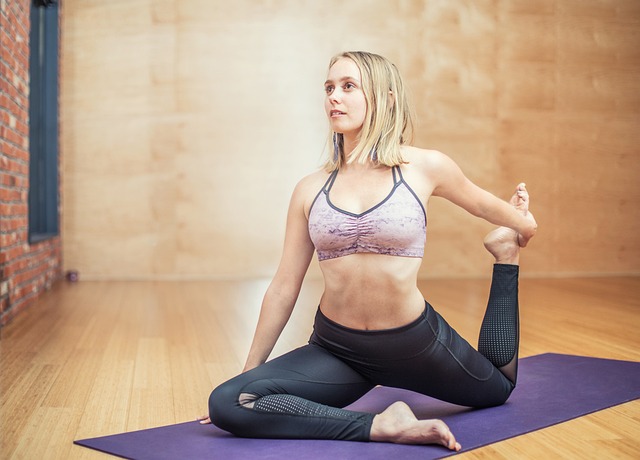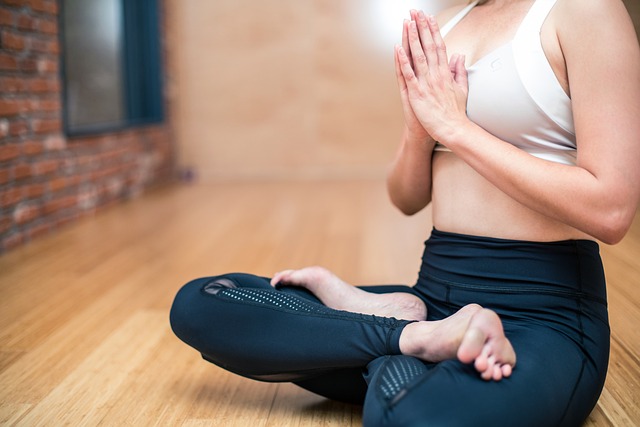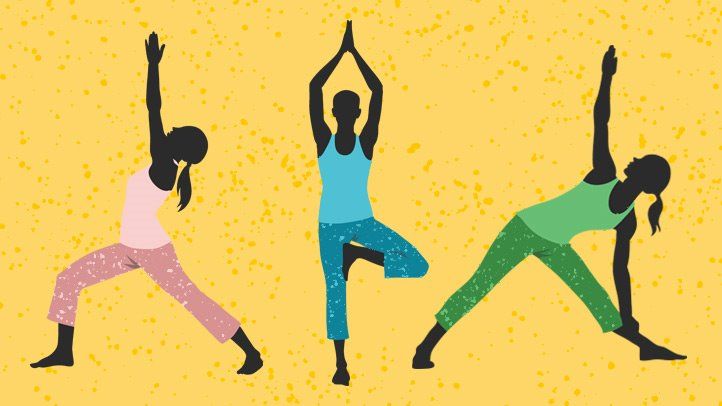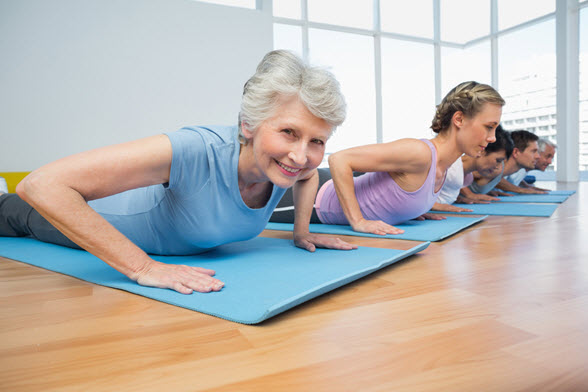
Discover the transformative power of yoga with these 10 essential poses that will unlock your body's incredible flexibility.
From the grounding strength of Downward Facing Dog to the empowering grace of Warrior II, this article will guide you through each pose, providing detailed instructions and insights to help you achieve a newfound sense of freedom in your practice.
Whether you're a seasoned yogi or a beginner on the path, these poses will inspire and challenge you on your journey to increased flexibility and personal growth.
Downward Facing Dog
Downward Facing Dog is a foundational yoga pose that promotes flexibility and strength in the entire body. This pose, also known as Adho Mukha Svanasana in Sanskrit, is widely practiced in yoga due to its numerous benefits.
When performing Downward Facing Dog, proper alignment is crucial to ensure maximum effectiveness and prevent injury. Begin by grounding the hands firmly into the mat, spreading the fingers wide. Engage the core and lengthen the spine, allowing the head to hang freely. The hips should be lifted high towards the ceiling, creating an inverted V-shape.
To modify this pose, one can use props such as blocks under the hands or a blanket under the heels. These modifications can help individuals with tight hamstrings or wrist issues to comfortably practice Downward Facing Dog.
Warrior I
Warrior I is a foundational yoga pose that focuses on alignment and balance techniques. By grounding through the feet and engaging the core, Warrior I helps to strengthen and stabilize the body.

Additionally, this pose stretches the hips, chest, and shoulders, promoting flexibility and opening up the front of the body.
Variations of Warrior I can be explored to deepen the practice and target specific areas of the body.
Alignment and Balance Techniques
In the realm of yoga, achieving proper alignment and balance is paramount for practitioners to experience the full benefits of the renowned Warrior I pose. To enhance the alignment and balance in this powerful pose, consider incorporating the following techniques and exercises:
- Grounding the feet: Start by firmly planting your feet hip-width apart. Press down through the four corners of each foot, creating a stable foundation.
- Square the hips: Ensure that your hips are facing forward, parallel to the front of your mat. Engage your core and draw your tailbone towards the floor, creating length and stability in the lower body.
- Find balance through the arms: Extend your arms overhead, palms facing each other. Keep your shoulders relaxed and away from the ears. Engage your triceps and gently draw your shoulder blades down the back, creating space and openness in the upper body.
Benefits and Variations Explained
The benefits and variations of the renowned yoga pose, Warrior I, are explained in this article. Warrior I, also known as Virabhadrasana I, is a powerful standing pose that strengthens the legs, opens the hips, and stretches the chest and shoulders. It is a pose that cultivates strength, stability, and focus.
To ensure proper alignment in Warrior I, start by grounding the back foot, keeping it at a 45-degree angle. Bend the front knee, making sure it aligns with the ankle, and engage the core to support the lower back. Lift the arms overhead, reaching towards the sky, while keeping the shoulders relaxed and away from the ears.
Modifications for Warrior I pose can be made to accommodate different levels of flexibility. For those with tight hips or limited range of motion, placing the back heel against a wall can provide stability and support. Another modification is to shorten the stance, bringing the feet closer together, which reduces the intensity of the pose.
Warrior II
One of the essential yoga poses for incredible flexibility is the dynamic and empowering stance known as Warrior II. This powerful pose not only strengthens the legs and opens the hips, but also cultivates a sense of inner strength and determination. Warrior II is a foundational pose in many yoga sequences and is often used to transition between poses.

Here are three advanced variations of Warrior II to further challenge and deepen your practice:
- Extended Side Angle Pose (Utthita Parsvakonasana): In this variation, extend one arm overhead and reach towards the front of the mat while maintaining the deep lunge of Warrior II. This pose increases the stretch in the side body and strengthens the core.
- Reverse Warrior Pose (Viparita Virabhadrasana): Begin in Warrior II and then gently lean back, dropping one hand to the back leg and reaching the other arm overhead. This pose stretches the side body and opens the chest, creating a beautiful arch-like shape.
- Bound Warrior Pose (Baddha Virabhadrasana): Starting in Warrior II, bring the hands behind the back and clasp them together, opening the chest and shoulders. This variation helps to improve balance and flexibility while also enhancing upper body strength.
Explore these advanced variations of Warrior II to challenge yourself physically and mentally, unlocking a new level of flexibility and freedom in your practice.
Triangle Pose
Continuing the exploration of essential yoga poses for incredible flexibility, the next pose to be discussed is Triangle Pose, which offers a unique combination of strength and stretch. Triangle Pose, or Trikonasana in Sanskrit, is a standing pose that engages the entire body, particularly the legs, hips, and core. This pose is known for its ability to increase flexibility in the hamstrings, groin, and hips, while also strengthening the legs and improving balance. The benefits of Triangle Pose extend beyond physical flexibility, as it also promotes mental clarity and a sense of grounding.
Modifications for Triangle Pose can be made to accommodate different levels of flexibility or physical limitations. For those with tight hamstrings, a block can be used under the lower hand to bring the floor closer and provide support. Additionally, a bent knee variation can be practiced to reduce strain on the lower back. Regardless of the modifications, the key is to maintain the integrity of the pose and focus on proper alignment.
With regular practice, Triangle Pose can help individuals not only achieve incredible flexibility but also experience a deep sense of freedom and liberation in both body and mind.
Child's Pose
Child's Pose, also known as Balasana, is a restorative yoga pose that offers numerous benefits. This pose gently stretches the hips, thighs, and ankles, while also relaxing the muscles of the back and shoulders. It is a great pose for releasing tension and finding calmness in both the body and mind.
There are also variations of Child's Pose that can be explored to cater to different levels of flexibility and comfort.

Benefits of Child's Pose
Child's Pose is a widely practiced yoga posture that offers a multitude of benefits when incorporated into a regular practice. This gentle pose, also known as Balasana, provides a sense of grounding and relaxation, making it an excellent choice for beginners and experienced yogis alike.
Here are the benefits of incorporating Child's Pose into your yoga routine:
- Deep relaxation: Child's Pose allows you to surrender and let go of any tension or stress in your body, promoting a state of deep relaxation and tranquility.
- Stretches the back: This pose gently stretches the muscles of the lower back, relieving any tightness or discomfort in that area.
- Calms the mind: By bringing your forehead to the mat and focusing on your breath, Child's Pose helps to calm the mind and promote mental clarity.
Modifications for Child's Pose: If you have knee or hip issues, you can place a blanket or bolster under your knees for added support. Additionally, if you have limited flexibility, you can widen your knees to create more space and comfort in this pose.
Variations for Child's Pose
One variation worth exploring for the pose discussed previously is the extended arm variation of Child's Pose.
This variation adds an extra element of opening and stretching to the traditional Child's Pose, providing even more benefits for the body and mind.
To practice this variation, start by sitting on your heels with your knees wide apart.
Extend your arms forward, placing your palms on the ground and allowing your forehead to rest on the mat.

This modification allows for a deeper stretch in the shoulders, upper back, and hips.
It is particularly beneficial for those who are looking to improve their flexibility and release tension in these areas.
Beginners can modify this variation by using a bolster or rolled-up blanket to provide support to the forehead or placing a block under the palms to decrease the intensity of the stretch.
Extended Puppy Pose
The Extended Puppy Pose is a foundational yoga posture that promotes flexibility and relaxation in the upper body. It is a variation of the popular Child's Pose, but with extended arms and a deeper stretch. Here are three benefits of practicing the Extended Puppy Pose:
- Increased flexibility: This pose stretches the spine, shoulders, and chest, helping to improve overall flexibility. Regular practice can lead to increased range of motion and a more open and supple upper body.
- Stress relief: The Extended Puppy Pose allows for deep relaxation and release of tension in the neck and shoulders. It can help to calm the mind, reduce anxiety, and promote a sense of peace and tranquility.
- Improved posture: By stretching the spine and opening the chest, this pose helps to counteract the effects of slouching and sitting for long periods. It encourages proper alignment and engages the muscles of the upper back, leading to improved posture and a more confident stance.
Incorporating the Extended Puppy Pose into your yoga practice can bring a sense of freedom and lightness to your body and mind. Explore different variations of this pose to find the one that best suits your needs and enjoy the benefits it brings.
Sphinx Pose
Sphinx Pose, also known as Salamba Bhujangasana, is a gentle backbend that offers numerous benefits for both the body and mind. This pose helps to strengthen the spine, stretch the chest and shoulders, and improve posture.
Additionally, Sphinx Pose promotes deep breathing and relaxation, making it a great pose for reducing stress and anxiety. Proper alignment in Sphinx Pose is crucial to maximize its benefits and avoid strain.

Benefits of Sphinx Pose
Sphinx Pose, also known as the Sphinx, offers numerous benefits for those looking to enhance their flexibility through yoga practice. This pose, which is a gentle backbend, helps to stretch and strengthen the spine, while opening the chest and shoulders.
The alignment in Sphinx Pose is crucial to reap its full benefits. To achieve proper alignment, ensure that your elbows are directly under your shoulders, your forearms are parallel to each other, and your palms are pressing firmly into the mat. Maintaining a neutral spine and engaging the core will further enhance the benefits of this pose.
Additionally, there are variations for Sphinx Pose that can be explored, such as lifting one leg at a time or bringing the hands closer to the body. These variations allow for a deeper stretch and increased flexibility.
Practice Sphinx Pose regularly to experience the freedom of a flexible and open body.
Alignment in Sphinx Pose
To achieve optimal alignment in the Sphinx Pose, it is important to focus on proper positioning of the elbows, forearms, and palms. Begin by lying on your belly with your legs extended behind you. Place your elbows directly under your shoulders, bringing your forearms parallel to each other. Your palms should be flat on the mat, fingers spread wide for stability.
As you lift your chest off the ground, engage your core, and press through your forearms, lengthening your spine. Keep your shoulders relaxed and away from your ears. To avoid straining the lower back, make sure your pelvis remains grounded. For those who need additional support, you can use a bolster or blanket under the forearms. This modification helps maintain the alignment and prevents strain.
Avoid common mistakes such as sinking into the shoulders or overarching the lower back. Remember, the goal is to find a comfortable and sustainable position that promotes freedom and flexibility.

To add variations to Sphinx Pose, you can deepen the stretch by lifting one leg off the mat or bringing your hands closer to your hips. Explore these variations to find what works best for your body and enjoy the benefits of increased flexibility and rejuvenation.
Bridge Pose
The Bridge Pose is a foundational yoga posture that is often used to improve flexibility and strengthen the back and glutes. Here are some best practices and modifications to enhance your practice:
- Start by lying on your back with your knees bent and feet planted firmly on the ground, hip-width apart. Keep your arms by your sides, palms facing down.
- Press your feet into the mat, engaging your glutes and lifting your hips off the ground. Keep your thighs and feet parallel.
- Roll your shoulders back and interlace your fingers under your hips, pressing your arms down into the mat for support.
Modifications:
- If you have neck or shoulder issues, place a folded blanket under your shoulders for extra support.
- For a deeper stretch, lift one leg towards the ceiling, keeping it in line with your hip and knee bent at a 90-degree angle.
The Bridge Pose not only opens up the chest and shoulders but also energizes the body and calms the mind. Incorporating this pose into your yoga routine will help you achieve greater flexibility and freedom of movement.
Seated Forward Bend
Continuing from the previous discussion on the Bridge Pose, let's now explore the Seated Forward Bend, a yoga posture that promotes flexibility and relaxation.
The Seated Forward Bend, also known as Paschimottanasana, is a gentle yet powerful pose that stretches the entire back of the body, from the heels to the spine.
The benefits of practicing the Seated Forward Bend are numerous. It helps to lengthen and strengthen the spine, improve digestion, and stimulate the kidneys and liver. This pose also stretches the hamstrings, calves, and hips, relieving tension in these areas. Moreover, it calms the mind, reduces anxiety and stress, and promotes a sense of inner peace and tranquility.

There are several variations of the Seated Forward Bend that can be incorporated into your practice. One variation is to use props, like a bolster or blanket, to support the torso and make the pose more accessible for beginners. Another variation is to practice the pose with a wide-legged stance, which further stretches the inner thighs and groins. Lastly, for those seeking a deeper stretch, the legs can be bound with a strap to intensify the stretch in the shoulders and hamstrings.
Incorporating the Seated Forward Bend into your yoga routine can bring incredible benefits to both your body and mind. By promoting flexibility and relaxation, this pose allows you to experience a greater sense of freedom and well-being.
Standing Forward Bend
As we delve into the realm of incredible flexibility, let us now explore the profound benefits of the Standing Forward Bend, a yoga pose that engages and stretches the entire body. This pose, also known as Uttanasana, offers numerous advantages for those seeking freedom in their movements.
The benefits of the Standing Forward Bend include:
- Enhances flexibility: This pose targets the hamstrings, calves, and hips, improving their range of motion and promoting suppleness in these areas.
- Relieves stress and anxiety: The act of folding forward and letting go in this pose releases tension in the neck, shoulders, and back, providing a sense of calm and relaxation.
- Stimulates digestion and circulation: The gentle compression of the abdomen in this pose aids in digestion and promotes healthy blood flow throughout the body.
Variations for the Standing Forward Bend include using props like blocks or a bolster to support the hands or resting the torso on the thighs for a deeper stretch. Explore these variations to find what works best for your body, and enjoy the freedom that comes with increased flexibility.
Frequently Asked Questions
What Are the Benefits of Practicing These Yoga Poses Regularly?
The benefits of regularly practicing yoga poses include increased flexibility, improved strength, reduced stress, enhanced mental clarity, and a greater sense of overall well-being. Modifications for beginners ensure accessibility and gradual progression in practice.
Are There Any Modifications or Props That Can Be Used to Make These Poses More Accessible for Beginners?
Modifications and props can be used to make yoga poses more accessible for beginners. Common mistakes can be avoided by providing alignment tips. By incorporating these modifications and props, beginners can gradually improve their flexibility and experience the freedom that yoga offers.

How Can These Poses Help Improve Flexibility in Other Areas of the Body, Such as the Hips or Shoulders?
Proper alignment is crucial in yoga poses to prevent injury and maximize the benefits. By consistently practicing essential yoga poses, gradually increasing flexibility in the hips and shoulders is achievable, leading to increased freedom of movement and a sense of liberation.
Are There Any Precautions or Contraindications for Individuals With Specific Injuries or Health Conditions When Practicing These Poses?
When practicing yoga poses, it is important for individuals with specific injuries or health conditions to take precautions. Modifications and the use of props can help beginners safely engage in the practice while preventing further harm.
Can These Poses Be Incorporated Into a Regular Yoga Routine? if So, How Often Should They Be Practiced for Optimal Flexibility Results?
Incorporating yoga poses into a regular routine can greatly enhance flexibility. To achieve optimal results, it is recommended to practice these poses consistently, aiming for at least three to four times per week.
 Business & FinanceHealth & MedicineTechnologyLifestyle & CultureScience & EnvironmentWorld NewsPrivacy PolicyTerms And Conditions
Business & FinanceHealth & MedicineTechnologyLifestyle & CultureScience & EnvironmentWorld NewsPrivacy PolicyTerms And Conditions
